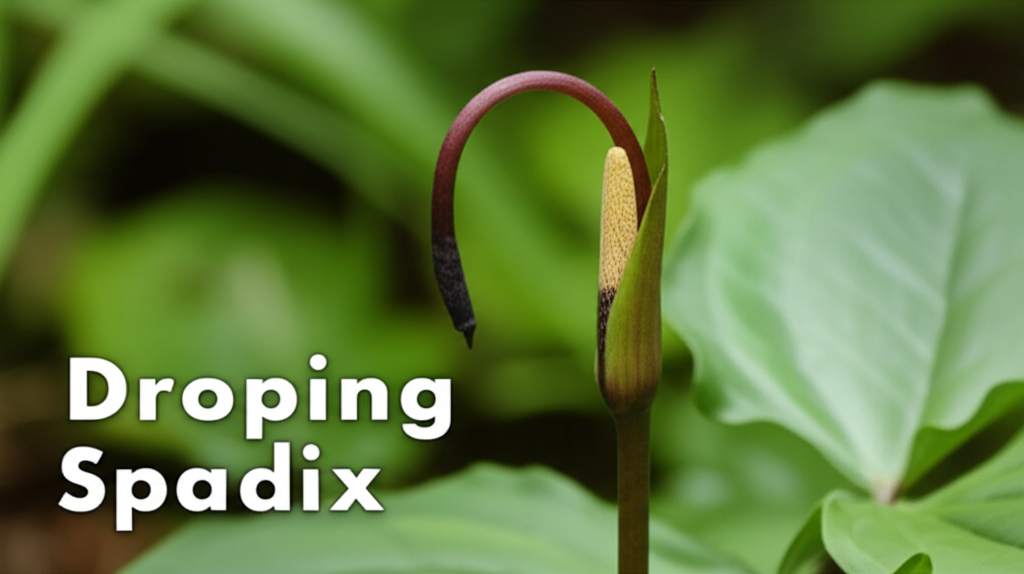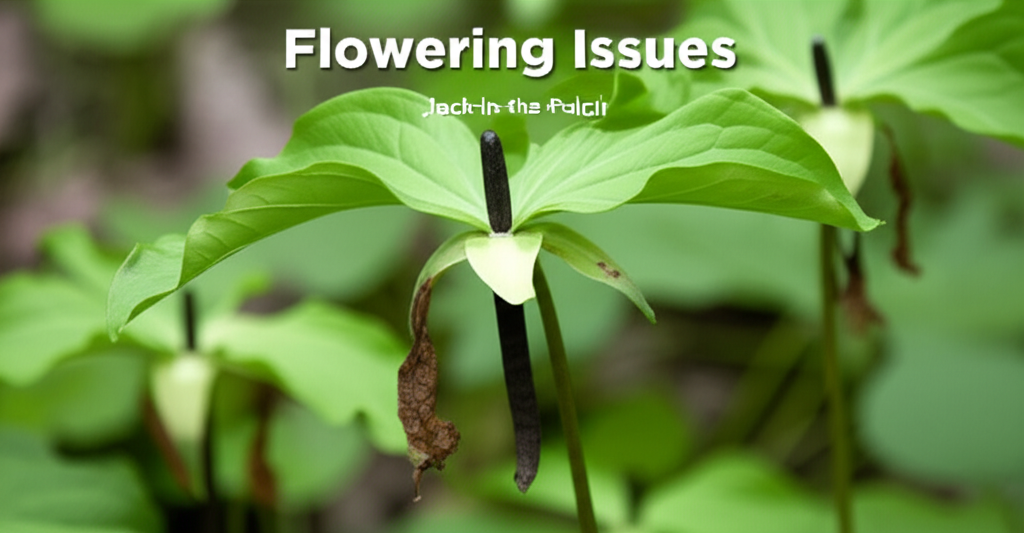Understanding the Jack-in-the-Pulpit (Arisaema triphyllum)
The Jack-in-the-Pulpit, scientifically known as Arisaema triphyllum, is a fascinating native woodland perennial recognized for its unique hooded spathe and spadix, resembling a preacher in a pulpit. This plant is a member of the Araceae family, which also includes beloved houseplants like Peace Lilies and Calla Lilies. Its natural habitat is moist, shady woodland floors across eastern North America, where it thrives in rich, organic soil.
A key characteristic of the Jack-in-the-Pulpit is its unusual reproductive strategy. Most plants that fail to flower are simply immature. A single corm (underground storage organ) must reach a certain size and age before it can produce the energy reserves necessary for flowering. Furthermore, Arisaema triphyllum is a sequential hermaphrodite, meaning an individual plant can change sex over its lifetime. Small, young plants are typically male. As they grow larger and accumulate more resources, they may become female, producing the characteristic red berries in late summer. A plant that successfully flowers (producing the spadix and spathe) will usually be female or hermaphroditic. This biological quirk is a primary reason why you might not see blooms.
Why Isn’t My Jack-in-the-Pulpit Flowering? Common Causes

Experiencing a lack of blooms from your Jack-in-the-Pulpit can be frustrating, especially when you’ve invested time and care into its growth. Several factors can contribute to this flowering issue, ranging from the plant’s age and health to its environmental conditions. Understanding these potential causes is the first step toward diagnosing and resolving the problem.
Key Factors Affecting Jack-in-the-Pulpit Flowering
Here’s a breakdown of the most common reasons why your Arisaema triphyllum might be withholding its spectacular bloom:
- Plant Immaturity: As mentioned, young plants simply haven’t accumulated enough energy to produce flowers. This is perhaps the most frequent reason for a lack of blooms.
- Environmental Stress: Any significant stress on the plant can divert its energy away from reproduction. This includes:
- Inadequate Light: While they prefer shade, they still need some filtered sunlight to photosynthesize effectively. Too much deep shade can hinder bloom production.
- Improper Watering: Both too little and too much water can be detrimental. Drought stress prevents flowering, while waterlogged conditions can lead to root rot, weakening the plant.
- Poor Soil Conditions: Jack-in-the-Pulpits require rich, well-draining soil with plenty of organic matter. Compacted or nutrient-poor soil will not support healthy growth or flowering.
- Nutrient Deficiencies: A lack of essential nutrients, particularly phosphorus and potassium, can limit the plant’s ability to produce flowers.
- Pests and Diseases: Infestations or infections can weaken the plant, making flowering a low priority for its survival.
- Over-Mulching: Excessive mulch can keep the soil too cold and damp, especially around the corm, and can also lead to rot.
- Transplant Shock: Recently transplanted plants often focus their energy on establishing roots rather than flowering for the first season or two.
- Incorrect Planting Depth: Planting the corm too deep can inhibit its ability to emerge and flower.
Troubleshooting Steps for Non-Blooming Jack-in-the-Pulpits
To effectively troubleshoot why your Jack-in-the-Pulpit isn’t flowering, you need to systematically assess its growing conditions and overall health. By addressing each potential issue, you can guide your plant toward successful blooming in the future.
Diagnosing the Root Cause
Start by carefully observing your plant and its environment.
- Assess Plant Age: Is the plant a seedling or a very small specimen? If so, patience is key. It may take several years for it to mature enough to bloom.
- Examine Light Conditions: Does the plant receive dappled shade for at least a few hours a day? If it’s in deep, perpetual shade, consider relocating it to a spot with brighter, indirect light. Conversely, if it’s receiving direct, hot afternoon sun, it will need more shade.
- Check Soil Moisture: Feel the soil around the plant. Is it consistently dry or soggy? The soil should be kept evenly moist but not waterlogged, mimicking its natural woodland habitat.
- Evaluate Soil Quality: Dig around the base of the plant (gently, to avoid damaging the corm). Is the soil compacted, sandy, or lacking in organic matter?
- Inspect for Pests and Diseases: Look for any signs of insect activity (aphids, slugs, snails) or unusual spots, wilting, or discoloration on the leaves.
- Review Mulch Layer: Is the mulch too thick or piled directly against the plant’s stem?
- Consider Recent Disturbances: Was the plant recently moved or planted?
- Check Planting Depth: If you planted it yourself, do you recall how deep it was buried?
Optimizing Growing Conditions for Blooming
Once you’ve identified potential issues, you can implement specific strategies to create an environment that encourages your Jack-in-the-Pulpit to flower.
Environmental Adjustments
- Light: Aim for dappled shade or partial sun. A location under deciduous trees that provide spring and summer shade is ideal.
- Watering: Maintain consistent moisture, especially during dry spells. Water deeply when the top inch of soil feels dry. Avoid letting the plant dry out completely or sit in standing water.
- Soil Improvement: Amend the soil with generous amounts of compost, leaf mold, or well-rotted manure. This will improve drainage and provide essential nutrients. If your soil is heavy clay, incorporate sand and organic matter to improve aeration.
- Fertilization: While Jack-in-the-Pulpits are not heavy feeders, a light feeding in early spring with a balanced, slow-release organic fertilizer can be beneficial. Focus on fertilizers with a good proportion of phosphorus (the middle number on the N-P-K ratio), which is crucial for blooming. Avoid excessive nitrogen, which can promote leafy growth at the expense of flowers.
- Mulching: Apply a layer of organic mulch (such as shredded bark, compost, or pine needles) around the plant, keeping it a few inches away from the stem. This helps retain moisture, suppress weeds, and regulate soil temperature.
- Pest and Disease Management: Address any pest or disease problems promptly. For slugs and snails, use barriers or organic slug baits. For fungal issues, ensure good air circulation and avoid overhead watering.
Key Facts and Comparison of Flowering Conditions
Understanding the ideal conditions versus common problem scenarios can help you pinpoint what your Jack-in-the-Pulpit might be lacking.
| Factor | Ideal Condition for Flowering | Common Problem/Cause of Non-Flowering |
|---|---|---|
| Age/Maturity | Mature corm (typically 3-5+ years old) | Young plant, insufficient energy reserves |
| Light | Dappled shade to partial sun (filtered light) | Deep shade (insufficient photosynthesis) or harsh direct sun (stress) |
| Soil Moisture | Consistently moist, well-draining | Drought stress (dry soil) or waterlogging (root rot) |
| Soil Type | Rich, humusy, well-drained | Compact, sandy, nutrient-poor, or heavy clay |
| Nutrients | Balanced with adequate phosphorus and potassium | Deficiencies in key nutrients |
| Watering Practices | Regular, deep watering when top inch is dry | Irregular watering, over/underwatering |
| Mulching | Moderate layer, away from stem | Excessive, tight mulching (cold, damp conditions) |
| Pests/Diseases | None | Infestations or infections weakening the plant |
| Transplanting | Established in place for at least 1-2 seasons | Recent transplanting, plant focusing on root establishment |
Understanding the Jack-in-the-Pulpit Life Cycle and Sex Change
The unique reproductive biology of Arisaema triphyllum plays a significant role in its flowering. As mentioned earlier, it is a sequential hermaphrodite.
The Process of Sexual Development
- Juvenile Stage: Young plants are strictly male. They produce pollen but cannot develop fruits. These plants focus their energy on growing larger.
- Transition to Female: Once a plant reaches a sufficient size and has accumulated a significant reserve of energy in its corm, it can transition to a female state. A female plant can produce the characteristic inflorescence (spathe and spadix) and subsequently the berries.
- Hermaphroditic Stage: Some plants may enter a hermaphroditic stage where they possess both male and female reproductive structures, though this is less common than purely female or male phases.
This life cycle means that even if a plant has the perfect growing conditions, it might not flower if it is still in its male-only juvenile phase. It needs to grow big and strong enough to support female reproductive development.
Steps to Encourage Flowering: A Proactive Approach
Rather than just reacting to a lack of flowers, adopting a proactive approach can significantly increase your chances of success.
| Step | Action | Purpose | Notes |
|---|---|---|---|
| 1. Site Selection & Planting | Choose a location with dappled shade and well-draining, rich soil. Plant corms at the correct depth (eyes facing up, about 2-4 inches deep). | Provides optimal growing environment and prevents planting errors. | Mimic its natural woodland habitat. |
| 2. Watering Routine | Water regularly, keeping soil consistently moist but not saturated. | Ensures adequate hydration for growth and energy storage. | Water deeply when the top inch of soil feels dry. |
| 3. Soil Improvement | Amend soil annually with compost or leaf mold. | Enriches soil, improves drainage, and provides nutrients. | Focus on organic matter. |
| 4. Fertilization Strategy | Apply a balanced, slow-release organic fertilizer in early spring. | Provides essential nutrients, especially phosphorus for flowering. | Avoid over-fertilizing with nitrogen. |
| 5. Mulching Practice | Apply a layer of organic mulch, keeping it away from the plant’s base. | Conserves moisture, moderates soil temperature, and suppresses weeds. | Prevents corm rot. |
| 6. Patience and Observation | Allow the plant ample time to mature and establish. Observe for signs of health. | Essential for plants to reach flowering size and overcome transplant stress. | It can take 3-5 years or more for a plant to mature. |
| 7. Pest & Disease Control | Monitor for and address any pest or disease issues promptly. | Ensures the plant has the energy to flower. | Healthy plants are more likely to bloom. |
When to Expect Blooms and What to Do If Flowering Persists
For most gardeners, seeing a Jack-in-the-Pulpit flower for the first time is a rewarding experience. However, it’s important to manage expectations regarding timing.
Patience is a Virtue
If your plant is young or has recently been moved, it might take a year or two to recover and begin flowering. The general rule of thumb is that a Jack-in-the-Pulpit needs to be at least 3-5 years old before it reliably flowers. If your plant is consistently healthy, has ideal growing conditions, and is of sufficient age, yet still refuses to bloom, re-evaluate the soil’s nutrient content. A soil test can reveal specific deficiencies. If all else fails and your plant is robust and well-established, it may simply be in a male phase and waiting to accumulate enough resources to transition to female. Continue to provide excellent care, and it will likely bloom in a future season.
Post-Bloom Care
Once your Jack-in-the-Pulpit has bloomed and begun to set berries (if it flowers as a female), continue to provide consistent moisture and care. The berries are attractive to birds and other wildlife. The foliage will yellow and die back in late summer or early fall, which is normal. Do not be tempted to cut it back prematurely; allow the leaves to naturally decompose, returning nutrients to the soil. This senescent phase is critical for the corm to store energy for the following year’s growth and potential flowering.
By understanding the plant’s unique needs and biology, you can effectively troubleshoot flowering problems and enjoy the captivating spectacle of your Jack-in-the-Pulpit blooming year after year.


